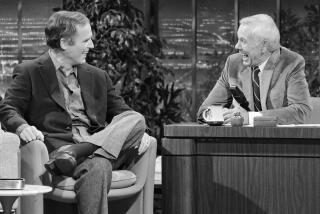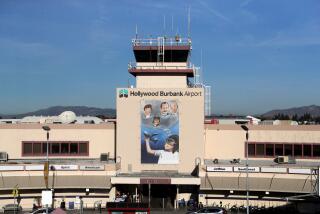Size at Heart of Airport Debate : Burbank: Neighbors agree that the terminal must be replaced to comply with FAA rules. But they object to making it four times larger than the current facility.
BURBANK — This much can be agreed upon: The aging terminal at Burbank Airport must be replaced to comply with orders from the Federal Aviation Administration.
But should it be expanded to more than four times its present size? That question is at the center of a simmering debate that has pitted airport officials against vocal opponents of the plan.
The Burbank Airport has gained popularity in recent years as a more convenient alternative to Los Angeles International Airport, thanks largely to low-fare carriers such as Southwest Airlines.
Operating revenues for the 1994-95 fiscal year are projected to be $56.4 million, more than double those of the past two years.
Airport officials say they must act to accommodate the 10 million passengers expected to fly in and out in the year 2010.
But some residents contend that steps are being taken to build a regional--and perhaps international--airport larger than many of them ever imagined.
Today the two sides will gather for a town hall meeting that is sure to be charged.
At the last such gathering, some Burbank residents complained that the president of the airport’s governing board, Brian Bowman, talked so much that not enough public comment was heard.
“A lot of times, there are walls built up artificially high that prevent proper dialogue,” said Chris Holden, a Burbank Airport commissioner. “The two have to coexist, and the two can coexist.”
Yet neither side seems willing to budge.
The airport’s present 163,000-square-foot terminal lies just 312 feet from the runway, but must be 750 feet away to comply with FAA safety regulations.
Airport officials hope to build a $185-million terminal just north of the present one, on 120 acres of land once used by the Lockheed Corp. to build military aircraft.
But three underlying factors hinder plans for the 670,000-square-foot facility that is supposed to be completed in two phases by the year 2010:
* Lockheed’s efforts to clean up contaminated soil in Burbank have been slow, and it is not clear how much longer work on the 120 acres will take.
* A Superior Court judge in January ordered airport officials to re-examine the potential for noise, traffic and air pollution that a new terminal might bring. The city of Los Angeles had sued the Airport Authority, charging that the board failed to properly study those issues.
Until the case comes before the judge again on Sept. 23, airport officials are prevented from purchasing land related to the terminal expansion, among other things, said Los Angeles Deputy City Atty. Keith Pritsker.
* Funding for the terminal expansion has not been found, but airport officials said they expect it will come from bond issues and federal grants.
Yet public support for the project has been all but silent, with the loudest voices belonging to opponents.
“We’ve never said we’re anti-airport. We’re anti-big airport,” said Jim Gordon, co-founder of the Burbank Flatlanders Home Protection League, a homeowners’ group with about 200 members.
“Whatever gains they make, they will have to fight for,” he added. “They want the moon and we’re willing to give them a little chunk of it.”
What airport Executive Director Tom Greer wants is for more people to recognize the economic benefits that the 435-acre facility brings now, including 38,000 jobs directly and indirectly related to operations.
“The airport,” he said, “can be the single most significant factor in continuing the economic revitalization of this area.
“We will never see, out of Burbank, an international flight to Japan or Australia or Europe. However, with NAFTA (North America Free Trade Agreement) it is quite possible we’ll see service into Mexico or Canada. . . . When we say we’ll never be international, we’ll never be transoceanic.”
A critical question in the debate over the airport’s future is how to define the role of the Airport Authority, the nine-member board in charge of operations.
Is it answerable to the public because the board’s commissioners are appointed by council members in Burbank, Glendale and Pasadena? Or is it an independent, separate legal entity, accountable only for its success in its mission to provide state-of-the-art regional airport facilities? Or both?
Airport commissioners themselves disagree on the answer.
“It is without question a governmental agency with lots of constituents,” said board president Bowman.
But Commissioner Holden, who is also a Pasadena councilman, said: “It’s quasi-governmental, with a leaning toward business.”
“There’s a sense of duty to provide information to the community,” he said. “But it is a business so we need to be mindful that the priorities set for the business will help the business flourish.”
Opponents of the terminal expansion suspect that making money is all the Airport Authority has in mind.
They claim Robert Garcin, a commissioner and until recently the board president, is aloof to their concerns and that the authority’s regular monthly meetings are purposely held Monday mornings so as to limit the amount of public input.
“The authority acts as though it’s running Vatican City. Their policy is to plunge ahead,” said R.C. “Chappy” Czapiewski an aviation buff who regularly attends the meetings. “It’s the Garcin attitude of damn the torpedoes, full speed ahead.
“The airport commission is absolutely determined to have its way, and damn the people. What’s different now is more people are more aware of what the Airport Authority is and how it operates,” Czapiewski said.
Strangely enough, the issue of expansion at the Burbank Airport was a hot topic even before the Airport Authority purchased the facility from Lockheed Aircraft Co. in 1978, with the help of taxpayers’ money.
In 1975, neighbors of the airport accused Burbank city officials of scheming to acquire the facility for the sake of expanding its operations.
Soon after, the City Council passed a resolution prohibiting expansion without a strong plan for minimizing increased noise and pollution.
That seemed to satisfy Burbank residents. The following year, residents in Burbank, Glendale and Pasadena voted overwhelmingly to approve the purchase.
A joint powers agreement among those cities creating the Airport Authority prohibited runway expansion and required that the airport take steps to mitigate noise.
Plans for the new terminal call for nearly twice as many aircraft gates as there are now, and almost double the number of flights. But airport officials insist that quieter commercial airplanes will be used to take off and land.
Debate over the proposal has spilled into Burbank City Council meetings, where a question about conflict of interest has swirled around two councilmen who are also airport commissioners.
More to Read
Sign up for Essential California
The most important California stories and recommendations in your inbox every morning.
You may occasionally receive promotional content from the Los Angeles Times.









